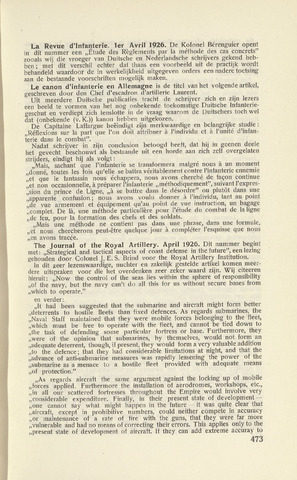473
La Revue d'Infanterie. Ier Avril 1926. De Kolonel Bérenguier opent
in dit nummer een „Étude des Règlements par la méthode des cas concrets"
zooals wij die vroeger van Duitsche en Nederlandsche schrijvers gekend heb
ben met dit verschil echter dat thans een voorbeeld uit de practijk wordt
behandeld waardoor de in werkelijkheid uitgegeven orders een nadere toetsing
aan de bestaande voorschriften mogelijk maken.
Le canon d'infanterie en Alleniagne is de titel van het volgende artikel,
geschreven door den Chef d'escadron d'artillerie Laurent.
Uit meerdere Duitsche publicaties tracht de schrijver zich en zijn lezers
een beeld te vormen van het nog onbekende toekomstige Duitsche Infanterie-
geschut en verdiept zich tenslotte in de vraag waarom de Duitschers toch wel
dat (onbekende (v. K.)) kanon hebben uitgekozen.
De Capitaine Laffargue beëindigt zijn merkwaardige en belangrijke studie
„Réflexions sur la part que l'on doit attribuer a l'individu et a l'unité d'infan
terie dans le combat".
Nadat schrijver in zijn conclusion betoogd heeft, dat hij in geenen deele
het gevecht beschouwt als bestaande uit een horde aan zich zelf overgelaten
strijders, eindigt hij als volgt
„Mais, sachant que l'infanterie se transformera malgré nous a un moment
„donné, toutes les fois qu'elle se battra véritablement contre l'infanterie ennemie
"et que le fantassin nous échappera, nous avons cherché de fagon continue
et non occasionnelle, a préparer l'infanterie „méthodiquement", suivant l'expres-
„sion du prince de Ligne, „a se battre dans le désordre" ou plutöt dans une
„apparente confusionnous avons voulii donner a l'individu, tant au point
„de vue armement et équipement qu'au point de vue instruction, un bagage
„complet. De la, une méthode particulière pour l'étude du combat de la ligne
„de feu, pour la formation des chefs et des soldats.
„Mais une méthode ne contient pas dans une phrase, dans une formule,
„et nous chercherons peut-être quelque jour a compléter l'esquisse que nous
„en avons tracée.
The Journal of the Royal Artillery. April 1926. Dit nummer begint
met: „Strategical and tactical aspects of coast defense in the future", een lezing-
gehouden door Colonel J. E. S. Bl ind voor the Royal Artillery Institution.
In dit zeer lezenswaardige, nuchter en zakelijk gestelde artikel komen meer
dere uitspraken voor die het overdenken zeer zeker waard zijn. Wij citeeren
hieruit: „Now the control of the seas lies within the sphere of responsibility
„of the navy, but the navy can't do all this for us without secure bases from
„which to operate."
en verder:
„It had been suggested that the submarine and aircraft might form better
„deterrents to hostile fleets than fixed defences. As regards submarines, the
„Naval Staff maintained that they were mobile forces belonging to the fleet,
„which must be free to operate with the fleet, and cannot be tied down to
„the task of defending some particular fortress or base. Furthermore, they
„were of the opinion that submarines, by themselves, would not form an
„adequate deterrent, though, if present, they would form a very valuable addition
„to the defencethat they had considerable limitations at night, and that the
„advance of anti-submarine measures was rapidly lessening the power of the
„submarine as a menace to a hostile fleet provided with adequate means
„of protection."
„As regards aircraft the same argument against the locking up of mobile
„forces applied. Furthermore the installation of aerodromes, workshops, etc.,
„in all our scattered fortresses throughout the Empire would involve very
„considerable expenditure. Finally, in their present state of development
„one cannot Say what might happen in the future it was quite clear that
„aircraft, except in prohibitive numbers, could neither compete in accuracy
„or maintenance of a rate of fire with the guns, that they were far more
„vulnerable and had no means of correcting their errors. This applies only to the
„present state of development of aircraft. If they can add extreme accuray to

